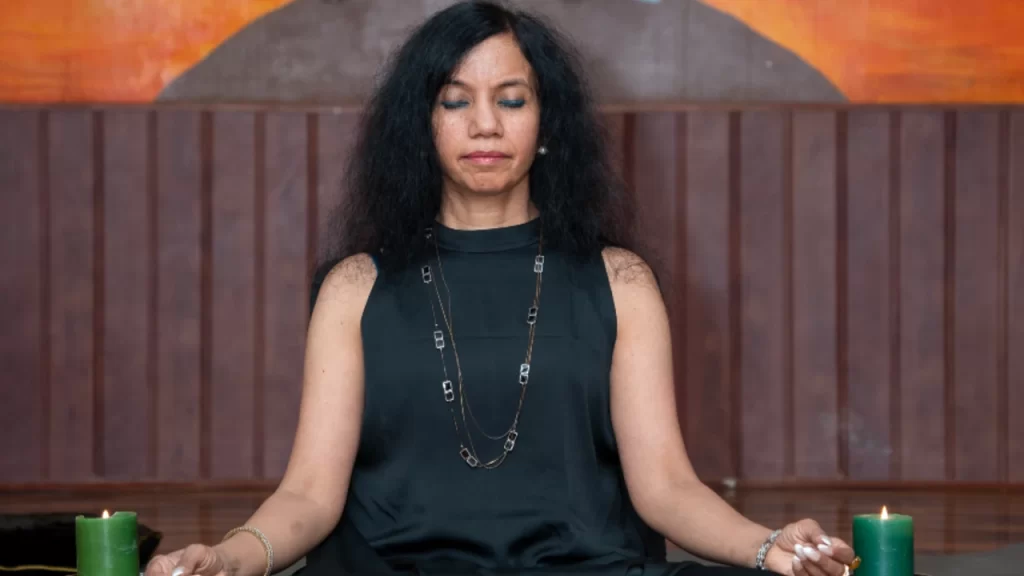Meditation is one of the most effective tools for balancing out the ill effects of stress and distraction, yet it can promote serenity and concentration. To enter deep meditation is more than just closing one’s eyes, sitting back, and taking slow breaths; it is actually achieving pure clarity and stillness in the mind. Deep meditation can only be reached with a tremendous amount of effort and time to master techniques that are beyond the surface level, allowing someone to transition from distraction to inner peace.
This book will take you step by step through how to go into deep meditation, teaching you what it’s all about and introducing alchemy energy healing and healing stone therapy as complementary techniques to further support your experience in meditation. These practices will help you discover how to go into deep meditation and unlock profound relaxation and spiritual growth.
Deep Meditation What is Deep Meditation?
How to Go Into Deep Meditation extends beyond common mindfulness by concentrating the mind in a deep calm, with fewer thoughts wandering, and creating a feeling of detachment from outer surroundings. How to Go Into Deep Meditation is not like normal meditation; it allows you to transcend habitual thought patterns and reach a higher level of consciousness.
According to a research paper published in Cognitive, Affective, & Behavioral Neuroscience, regular meditators typically exhibit increased alpha and theta brain waves. Such brain waves are associated with relaxation and creativity, the kind of activity perfect for deep meditation, and therefore all the benefits that come along with it, such as a clear mind, reduced anxiety, and emotional well-being. Doing How to Go Into Deep Meditation is not only meant to relax but to make the individual emotionally balanced and cognitively clear. The benefits of these kinds of meditative practice become more amplified
1.Set Up Your Meditation Space
Creating a conducive space for meditation is important. Choose an area that has minimal noise, is neat, and not likely to be disturbed. Add anything that will make you relaxed, such as soft light, comfortable seating, or aromatherapy.
Improving your meditation space by using healing stones like amethyst or rose quartz heals the energy and promotes a relaxing state. Some might help deepen your meditative state by providing grounding energy through healing stone therapy.
2. Practice deep breathing exercises
Preparing the body for meditation is calming of the mind through deep controlled breathing. Probably the best is 4-7-8 breathing. This slows down the heart rate, allows the patient to relax and it becomes relatively easy to transition to states of deep meditative level.
The benefits of respiratory exercises lie in the stimulation of the parasympathetic nervous system within the body. This type of functioning promotes the relaxing response hence it is relatively easy to drift into a state of deep meditation.
3. Use a Guided Meditation or Visualization
Guided meditation is a great resource for beginners. With guided sessions, verbal instructions can be provided that keep your mind focused, prevent it from drifting, and bring about relaxation. There are many apps, like Calm and Insight Timer, that offer guided meditations specifically designed to deepen your practice.
Techniques to Go into Deep Meditation
Consistency and the use of some specific techniques are the needs for deep meditation. Some effective techniques that can be employed in order to reach a deeper state of consciousness include:
1. Mindfulness Meditation
Mindfulness meditation is the practice of being within the present moment. Here, one is expected to observe the thoughts without attachment. You can stay completely in the present in order to learn to let go of those distracting thoughts and plunge into the state of heightened awareness.
In the practice of mindfulness meditation:
- Sit comfortably.
- Pay attention to your breath, feeling each inhale and exhale.
- Notice thoughts that arise without judgment as they pass.
Tip: Regular mindfulness practice can hone your ability to enter deep meditative states over time.
2. Body Scan Meditation
A body scan meditation is a technique where one focuses the attention on different parts of the body, letting go of the tension built up, and paying great attention to the physical sensations within the body. It will be most effective for one who has trouble quieting the mind as it includes a concrete focus point that is hard to find other places in meditation.
Guidelines for performing a body scan meditation:
- Let each area relax as you move along.
- Start on the top of your head and work your way, slowly down to your toes.
- Pay attention to what it feels like at each segment; you can observe sensations that feel tight or loose.
Complementary Practices to Enhance Deep Meditation
Complementary practices can enhance the positive effects of deep meditation. Here is how integrating methods like alchemy energy healing, life counseling, and healing stone therapy can benefit you:
1. Alchemy Energy Healing
Alchemy energy healing deals with balancing and harmonizing the body’s energy fields. It is a process of removing emotional and energetic blockages in order to create a more clear pathway for meditation.
Adding alchemy energy healing to your meditation practice will help you:
- Remove negative emotions.
- Recover mental clarity.
- Enhance overall energy flow.
How to do it: To work on this, seek out a professional energy healer and go through sessions with that person that are designed to upgrade your meditative practice.
2. Life Counseling and Life Coach India
Life coaching and counseling might be helpful to discover your life areas that can affect your mental peace. A life coach India or any similar resource will help you set your personal growth goals, detect the mental roadblocks, and get you moving on a road of higher self-awareness.
A counselor or a life coach can also support you in increasing motivation toward a regular meditation routine.
Provide apparatus on dealing with stress and anxiety.
Overcoming Challenges in Deep Meditation
Sometimes, it becomes difficult to go deep into meditation. Here are some common problems and how to overcome them:
1. Difficulty Concentrating
If you are unable to keep your mind steady during meditation, you could try using a mantra or visualization technique. Repeating an easy phrase or visualizing a peaceful scene can really keep the mind anchored, preventing mental drift.
2. Restlessness and Body Aches
Physical discomfort is another common hindrance to beginning. Improve your posture, use pillows, or lie down when necessary. Prior to meditation, practice in progressive relaxation can also help dissolve any remaining tension.
3. Intrusive Thoughts
Do not try to suppress thoughts; view them and let them pass without attachment. Meditation is not about control but observing your mind.
Measuring Your Progress in Deep Meditation
Most of you will see many changes in your life when you start practicing deep meditation. Here are some things that tell you that you are doing just fine:
Better Concentration: You can stay focused for a much longer time without losing your attention span.
Reduced Anxiety:It would be less anxious, much calmer during the day.
Better sleep: Most people report that meditation improves their sleeping time as it removes nighttime anxiety and relaxes.
A Habit of Regular Meditation
A consistent practice of meditation is essential to gain the long-term benefits. Here is how you can establish such a routine:
Make it a Routine: Choose a specific time for the day to meditate. Early morning is good, but any quiet time can be used.
Start small: 5-10 minutes, gradually increasing as you become comfortable with the activity.
Use reminders: Apps and reminders will help you be more consistent, even on busy days.
Resources and Tools for Deep Meditation
This has some good resources to make your way into deep meditation.
Insight Timer: It offers free guided meditation as well as music and an online community.
Calm: It includes meditation, sleep, and relaxation, with guided meditation, sleep aids, and breathing exercises.
Aura: It’s for sleep and anxiety; this app is fantastic if you are looking for guidance in these areas.
Final Thoughts on How to Go into Deep Meditation
Learning how to go into deep meditation can be deeply transformative. By developing this skill, you gain access to an inner state of tranquility, enabling a stronger ability to handle anxiety and resolve everyday challenges. Over time, the practice of how to go into deep meditation fosters positive changes in mental clarity and emotional resilience, making it an essential part of personal growth.
Remember, how to go into deep meditation is a journey, not a destination. Whether you are exploring family constellation or adding healing stone therapy to your routine, the key is consistency and patience. Embrace the process, and let each session take you one step closer to inner peace.







Leave a Reply